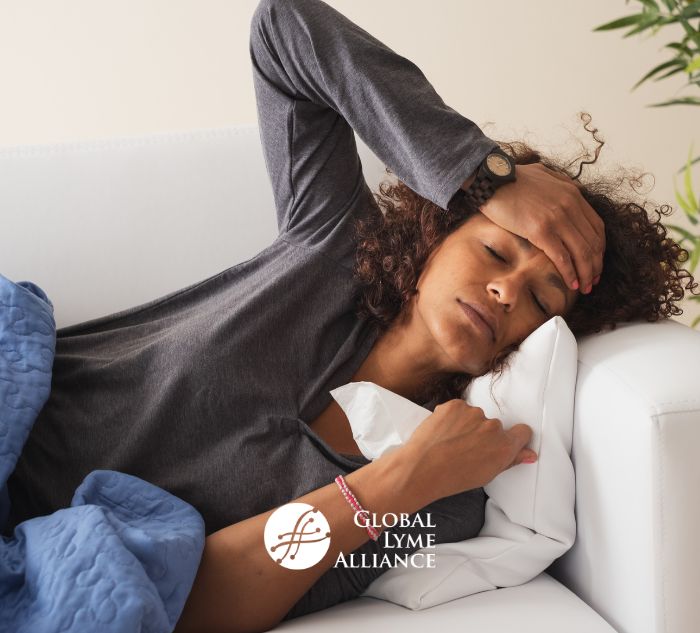
Learn how to manage Lyme disease flares with tips on symptom tracking, self-care, pacing, and seeking medical attention. Expert advice for navigating symptom exacerbations.
One of the most frustrating aspects of Lyme disease is that recovery isn’t linear. Even if you have a relatively simple case that clears up with a few weeks of antibiotics, you’ll probably experience peaks and valleys of symptoms during that time, especially if you have a Herxheimer reaction. And because 10-20% of patients with treated early Lyme disease still go on to experience persistent symptoms, you may be waiting for the proverbial shoe to drop, wondering if or when symptoms might flare.
Those of us whose Lyme disease was not diagnosed until the case was very advanced tend to have a relapsing version of the disease. My own case of Lyme, complicated by the co-infections babesiosis and ehrlichiosis, as well as chronic active Epstein-Barr virus, was not diagnosed until eight years after I was bitten by a tick. By then the infection had spread throughout my body and crossed the blood-brain barrier into my central nervous system, leaving me bedridden. It took many years battling active infection, and one relapse, before I achieved and maintained remission.
What does it mean to be in remission from Lyme disease? I explore this question in detail in my blog post “What it Means to Live with Chronic Lyme Disease.” The short answer for me is that my infection, and subsequent symptoms, are dormant most of the time but flare periodically, particularly during times of stress or when my body is hit with another illness. Each time that happens, I fear I’m relapsing, but as long as I take care of the symptoms—and myself—quickly and properly, I am able to work through the flare.
Here are some strategies I’ve learned for managing Lyme disease flares and symptom exacerbations:
Keep a symptom log
Every day, I jot down a few notes about what I did that day and how I felt. I include how I slept the night before, any changes I made to my usual routine (including outside stressors or changes to diet or medication), and any symptoms I experienced. Keeping a log helps me chart patterns, progress, and flares. I read through the log before seeing my Lyme Literate Medical Doctor (LLMD) and write a summary to provide at the visit. Then we determine together if specific symptoms seem to be flaring regularly, or if certain stressors seem to exacerbate symptoms. You can create your own log or you might find it useful to fill out a template such as the downloadable Daily Symptom Diary on the Harvard Health Publishing Lyme Wellness Initiative website.
Determine if it’s a Lyme disease flare or a symptom exacerbation
If you’re suddenly feeling sick again, it’s important to ask yourself, are you feeling just one specific symptom and is there an external factor that seems to be exacerbating it? For example, if you’re having an uptick in sleep disturbances, might they be a result of pushing your body too hard physically or neurologically, and do the disturbances abate if you tone down your schedule for a few days? That’s a specific symptom exacerbation caused by a factor that you can personally control.
If, on the other hand, your sleep disturbances don’t seem to be a result of any unusual external factors and you’re also experiencing other Lyme disease symptoms that you haven’t in a while (such as increased fatigue or joint pain), that could be a sign that the infection itself is flaring. Before you panic, try some of the self-care techniques listed below and wait a few days to see if the flare passes. If it doesn’t, it’s probably time to consult your LLMD to see if you need to either restart or adjust treatment.
Pace yourself
Even when I’m feeling well, I’ve learned that I need to pace myself physically or neurologically or my Lyme and co-infections will flare. This means stopping while I’m ahead when I’m exercising or working by taking frequent breaks before my body or brain really needs them. It may take some trial and error to figure out how to pace yourself, but over time, doing so will feel more natural. You’ll also start to learn what limits you can and cannot push.
Rest
When I experience any type of Lyme disease flare, it’s usually my body’s way of telling me that I’m pushing myself too hard and need to rest. This may mean taking a few sick days from work. Or it may just mean just doing a little less and sleeping a little more until I feel better. Pushing through symptoms or fatigue always makes me feel worse. It can be frustrating to back off from a schedule that otherwise works for you, or to have to say no when for so long you’ve been able to say yes, but doing so helps you move through flares and get back to living faster.
Self-care
Once you start to feel well, it can be easy to jump right back into all that you’ve missed, and then find yourself crashing again. This happened to me when I first went off treatment. I went right back to the fast pace of living I’d always known, diving into work and moving back out on my own. Without any defenses in my system, my body was quickly overwhelmed, and the Lyme disease bacteria (spirochetes) ran rampant once more. Within three months, I found myself bedridden and on antibiotics again.
I had to accept that there was no going back to the pre-illness life I’d known. Instead, I had to figure out how to best move forward with Lyme disease and co-infections, knowing that I needed to care for them as part of my life. In addition to pacing myself, this meant finding work that was manageable, seeking help with tasks like grocery shopping and cleaning so I could save energy, making time for joy and pleasure without guilt, eating well (I follow the “Lyme Diet”), maintaining proper sleep hygiene, exercising as tolerated, and thinking about ways to nourish and nurture my whole self.
It might help to create a self-care list and post it somewhere you can see it every day.
Make minor adjustments
One of the most important ways I’ve sustained remission is by strictly following my doctor’s recommendations, taking all of my medications and supplements, and maintaining my self-care routine. Letting any of those things slide can pretty much guarantee me a flare or symptom exacerbation. Sometimes when I do have a flare, I need to increase some of these techniques. That may mean increasing a certain supplement (with the approval of my doctor). It may mean eliminating something from my diet. It may mean decreasing exercise.
Know when to seek medical attention
When I experience symptom exacerbation, I try the above techniques before contacting my doctor. If the symptom doesn’t subside, I reach out to my doctor for recommendations. It’s especially important to do this if you’re feeling like you’re experiencing a true flare-up of infection, because the faster you get back on or adjust treatment, the sooner you can get back to feeling well.
***

Jennifer Crystal
Writer
Opinions expressed by contributors are their own. Jennifer Crystal is a writer and educator in Boston. Her work has appeared in local and national publications including Harvard Health Publishing and The Boston Globe. As a GLA columnist for over six years, her work on GLA.org has received mention in publications such as The New Yorker, weatherchannel.com, CQ Researcher, and ProHealth.com. Jennifer is a patient advocate who has dealt with chronic illness, including Lyme and other tick-borne infections. Her memoir, One Tick Stopped the Clock, was published by Legacy Book Press in 2024. Ten percent of proceeds from the book will go to Global Lyme Alliance. Contact her via email below.
